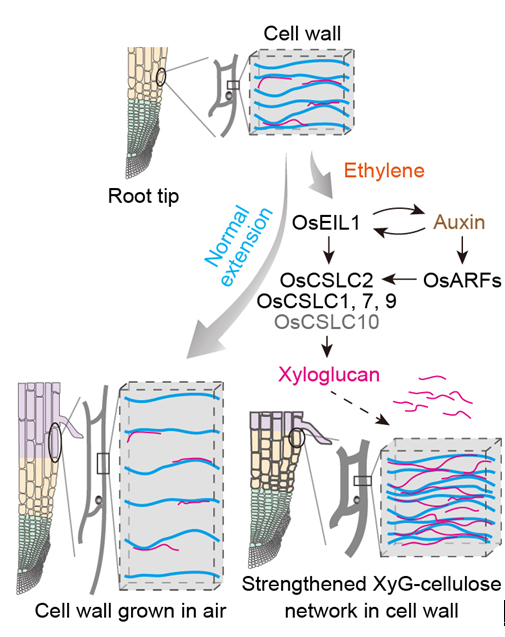Researchers led by Prof. ZHANG Jinsong and Prof. ZHOU Yihua from the Institute of Genetics and Developmental Biology (IGDB) of the Chinese Academy of Sciences have shown that ethylene inhibition of root growth depends on CELLULOSE SYNTHASE-LIKE C proteins-mediated xyloglucan (XyG) induction in the cell wall of rice.
Phytohormone ethylene is involved in many aspects of plants. How does ethylene control plant growth? Although the processes of the ethylene signaling pathway and signaling regulation are now almost clear, the understanding of where the ethylene signal is output downstream for growth regulation is still limited, especially in crops, such as rice.
Plant cells are encased in a cell wall which determines the morphogenesis of plant cells and the plastic growth of plants. The cell wall is composed of macromolecular polysaccharides, highly glycosylated proteins, and lignin, forming a complex and dynamic polysaccharide network. Is there a relationship between ethylene regulation of plant growth and cell wall formation?
The changes in cell shape, cell wall thickness, cell wall components and gene expression drew the researchers' attention to cell wall synthesis during ethylene inhibition of root growth. The overexpression, mutant, and genetics analyses supported that OsCSLC2-mediated and ETHYLENE-INSENSITIVE3-LIKE1 (OsEIL1)-regulated XyG accumulation in the epidermal cell walls of the root elongation and differentiation zone is indispensable for the ethylene inhibition.
After several experiments, the researchers finally observed a stronger phenotype of root ethylene response using higher order mutants of the CSLC gene family. Another issue regarding the interaction between XyG and cellulose remains a challenging aspect that requires further research.
In conclusion, this study demonstrates that ethylene induces XyG and cellulose accumulation in root cell walls by upregulating the expression of OsCSLC1, 2, 7, 9, 10 and CELLULOSE SYNTHASE A3, 4, 7, 9 in an OsEIL1 and auxin pathway-dependent manner.
These findings link plant hormone signaling to cell wall establishment, broadening the understanding of root plastic growth in rice and other crops.
A proposed working model showing that the ethylene pathway and auxin pathway work together to promote the expression of OsCSLC2 and its homologs for XyG synthesis and accumulation in the cell wall to inhibit cell elongation and hence root growth during the root ethylene response of rice seedlings. (Image by IGDB)







